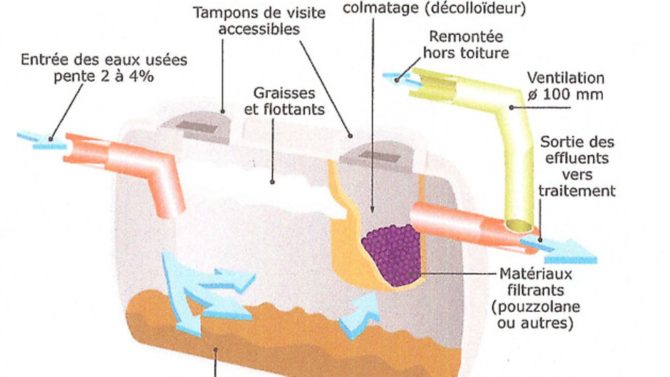How a septic fosse works

Mary Hall explains the workings of the fosse septique in France

Dealing with several cases of nasty niffs and gurgling drains recently, I’ve realised that many people don’t know much about the basics of fosse toutes eaux drainage systems. Here I’ll explain how a fosse works, next month I’ll talk about maintenance and inspection (contrôle) issues.

Firstly, note that although the terms tend to be used interchangeably strictly speaking a fosse septique refers to a system which collects water solely from the WCs, whereas a fosse toutes eaux, the sort which has been current for some years now, takes all waste water from bathrooms and kitchens. Rainwater shouldn’t be going through either type.
In simple terms, a standard modern non-mains foul drainage system (assainissement non-collectif) comprises four parts: collection, pre-treatment, treatment and evacuation.
COLLECTION
This phase consists of the pipework that collects all the waste water from the kitchen and bathrooms and deliver it to the fosse. If the fosse is more than 10m away from the kitchen there should be a grease trap (bac à graisse) to filter the kitchen waste on the way.
PRE-TREATMENT
This is the job of the fosse, a large tank (the volume of which should be calculated on the basis of the number of bedrooms, existing and proposed, when installed). Note that the tank is filled with water after it’s installed: it’s not the flushing of your toilets or bathwater which fills it up. In the tank the waste separates, with heavier particles sinking to the bottom and forming sludge, and lighter particles floating on the surface creating a layer of scum. In between there’s murky liquid effluent. Natural bacterial action works to liquefy the waste. If you’re technically minded, the bacterial action affecting the floating scum layer is aerobic as it relies on oxygen available from the air above, whilst anaerobic bacteria digest suspended waste in the effluent and sludge. The process deals with some 30% of the waste, and takes 2-3 days. It’s a continual process, as more waste enters existing liquids flow out at the far end of the tank. Activators such as Eparcyl, Septifos and Tarax, flushed down the wc on a regular basis, help keep the bacteria happy.
As it leaves the tank, a pre-filter (usually, but not all tanks have them) captures much of the suspended matter. It’s like a basket containing rocky lumps, usually ‘pouzzolane’, and can be pulled out of the second inspection chamber for pressure-hose cleaning.
TREATMENT
The partially purified liquid effluent from the fosse then passes through a filter bed, or filtered land drain, where natural processes remove the remaining pollutants. The size and type of drainage field will depend upon the nature of your soil and subsoil. The drainage field must never be paved over, or be subject to vehicular traffic. Leaving it as lawn or pasture is best, never plant trees or shrubs on or within 3m of it as their roots will interfere with the drainage system.
EVACUATION
Finally, the purified water drains naturally into the ground, or is piped into a nearby ditch.
Ventilation:
It is essential that the system is properly vented through 100 mm pipes to avoid odours and pollution. The primary ventilation is taken from the WC downpipe straight through the roof.
Secondary ventilation is required from the fosse to evacuate the noxious gases (hydrogen sulphide and methane) generated by the bacterial action inside. It’s taken from the top of the fosse, or the outlet pipe, and vented to an outside wall of a nearby building, generally to above the eaves but at least to a height well above any opening windows. It has to catch fresh blowing air.
FUNCTION OF A GREASE TRAP
The insolubility of grease, oil and fats is a problem for sewage collection and treatment. Grease and fat in a warm solution may appear to flow freely but as the liquid cools the grease and fat congeal and this eventually coats waste pipes causing blockages. If your fosse is more than 10 metres from the kitchen (the major producer of grease) you must have a trap : a bac à graisse.
The trap works by slowing down the flow of warm or hot fatty water, thereby allowing the liquid to cool sufficiently so that the grease and oil separate and float to the top of the chamber. The fatty layer solidifies and can be removed quite easily from the top when necessary (more about this lovely job next month).
Now you know how it works, hopefully you’ll understand why you should avoid disposing of things down the WC.
One of my friends has a neat notice in her loo which reads ‘Please do not flush anything down this loo which hasn’t passed through your digestive system first. The only exception is the toilet paper provided’. NIcely put!
Mary Hall is a Chartered Surveyor
Tel 0033 (0)5 65 24 66 46
Share to: Facebook Twitter LinkedIn Email


